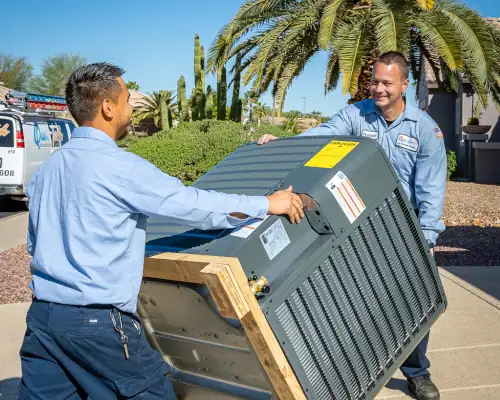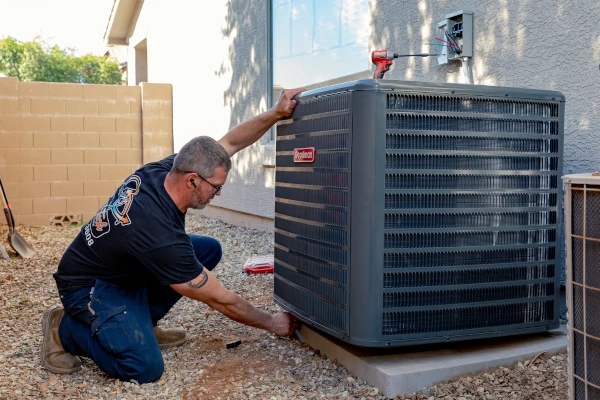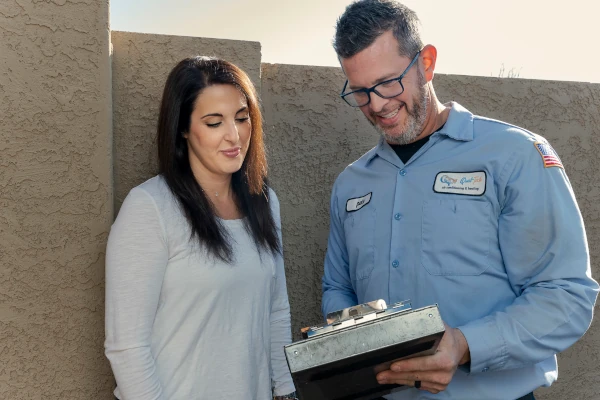Imagine a world where your air conditioner is considered an environmental hazard, or where a simple AC costs as much as a luxury car. This isn’t science fiction—it’s the reality we’re rapidly approaching in the world of HVAC. The humble AC refrigerant, a substance most of us never see or think about, is at the center of a global shift that’s reshaping how we keep our spaces comfortable. From the ban of ozone-depleting R-22 to the phaseout of R-410As due to its impact on global warming, the story of HVAC refrigerants is one of constant evolution, driven by environmental concerns and technological advancements. As we stand on the brink of another major transition in cooling technology, understanding these changes is crucial—not just for industry professionals, but for anyone who enjoys the comfort of climate control. Join us as we explore the past, present, and future of HVAC refrigerants, and uncover why the air you’re breathing right now might be more expensive than you think.
How do AC Refrigerants Work?
To make it simple, a refrigerants is a liquid that transfers heat when it changes states. It soaks heat in when it evaporates, and lets it out when it condenses. A compressor propels AC refrigerant in a loop. The refrigerant evaporates on one end and condenses on the other. The fluids are meant to change from liquid to gas very easily, aiding the efficiency of the unit. Many things can be used as refrigerants, including water, but not everything is a good refrigerant. Some refrigerants are much better and more efficient than others.
Why Do Refrigerants Keep Changing?
The phaseout of AC refrigerants is primarily driven by global environmental concerns and government regulations. International agreements have been compelling manufacturers and consumers to adapt to new refrigerant standards for years. While this has been happening for a long time, we’ll start with the phase-out of R-22, also known as Freon, and make our way through R-410A to discuss what the next standard for AC refrigerants might be be.
What AC Refrigerants are There?
R-22 - "Freon"
Freon, a brand name for R-22, was widely used in refrigeration and air conditioning systems for decades. Developed by DuPont in the 1930s, it gained popularity due to its stability, non-toxicity, and efficiency. Freon replaced more dangerous AC refrigerants like ammonia and sulfur dioxide. It was used in various applications, from household refrigerators to industrial cooling systems. However, its widespread use came to an end when its harmful environmental effects were discovered.
Ozone Concerns

Freon was shown to deplete the ozone layer, allowing harmful ultraviolet radiation to reach Earth’s surface. This increases risks of skin cancer, cataracts, and damage to plants and marine ecosystems. This led to international efforts to phase out Freon and similar substances under the Montreal Protocol.
If you have an old AC it’s likely you’re still using R-22 Freon. Refrigerant leaks can deplete your system of it’s Freon, not only releasing it into the atmosphere, but also necessitating a refill. While reclaimed Freon is still available, it’s very expensive, since it is no longer manufactured. It’s recommended to replace a leaking R-22 system with a new system to avoid future issues with Freon availability. If you’d like to know more about the R-22 phaseout, read this article by Goodman.
R-410A - "Puron"
Puron, also known as R-410A, is a refrigerant that was introduced as a more environmentally friendly alternative to Freon. Developed by Carrier Corporation, it became widely used in residential and commercial air conditioning systems since the 2000s. R-410A operates at higher pressures than its predecessors, allowing for more efficient cooling. It doesn’t contain chlorine, making it harmless to the ozone layer. This refrigerant quickly became the industry standard for new AC systems.
Global Warming Concerns
While R-410A doesn’t deplete the ozone layer, it’s a potent greenhouse gas with high global warming potential (GWP). This led to its inclusion in the Kigali Amendment to the Montreal Protocol, which mandates its phasedown. Many countries are now banning or restricting R-410A use in new equipment. R-410A is going to be phased out by 2025, 34 years after its invention.
After the ban, existing R410A systems can continue operating. However, as supplies dwindle, maintenance and recharging costs will undoubtedly increase. Homeowners aren’t required to replace functioning R410A systems immediately but should consider upgrading to newer, more environmentally friendly options when their current system reaches the end of its lifespan.

Since R410-A is one of the most prominent AC refrigerants currently in use, its ban has caused massive upheaval in the HVAC world. Manufacturers have been quick to respond and roll out new AC refrigerants to replace R410A. We’ll take a look at some of the new AC refrigerants and see which are best for your home. If you’d like to know more about the refrigerant, check out this Super Radiator Coils blog post.
R-32 - "Freon 32"
R-32 (difluoromethane) is a single-component refrigerant gaining popularity as a replacement for R410A and an alternative for R454B. R-32 offers high energy efficiency, especially in hot climates. While mildly flammable (A2L classification), its performance benefits and reduced environmental impact make it a strong contender in the evolving HVAC refrigerant market.
Flammability

R-32 is classified as an A2L refrigerant, meaning it’s mildly flammable. A2L refrigerants have a lower burning velocity and require higher concentrations to ignite compared to more flammable substances. In practical terms, you’d need a significant leak in a small, poorly ventilated area, plus a powerful ignition source like a large open flame or a strong electrical arc. Normal electrical switches or static electricity won’t light it. While A2L refrigerants like R-32 are technically flammable, but don’t pose a significant danger.
For the HVAC industry, however, the A2L classification of R-32 necessitates some changes in equipment design, handling procedures, and technician training. While these adjustments are significant, they’re manageable and offset by R-32’s environmental and performance benefits. Many manufacturers are already adapting their products and practices to accommodate A2L refrigerants.
Efficiency
R32 has greater efficiency than R410A, offering superior cooling capacity while requiring a lower refrigerant charge. This improved performance translates to better energy utilization in air conditioning and heat pump systems. R32 also allows for more compact system designs due to its thermodynamic properties, potentially reducing overall equipment size and material usage.
Environmental Impact
R32 has a significantly lower global warming potential (GWP) of 675 compared to R410A’s 2088, reducing its direct environmental impact by about 68%. This lower GWP, combined with R32’s higher energy efficiency, results in a smaller carbon footprint for air conditioning and heat pump systems. R32 also requires less refrigerant charge, further decreasing its environmental impact. However, R32’s mild flammability introduces new safety considerations for handling and disposal.
For more information about R-32 refer to this comprehensive blog post by Super Radiator Coils. Daikin also has a promotional article about R-32.
R-454B
R-454B is an emerging refrigerant blend, considered a leading replacement for R410A in air conditioning systems. It’s a mixture of R-32 (difluoromethane) and R-1234yf (2,3,3,3-tetrafluoropropene), offering a significantly lower global warming potential (GWP) of 466 compared to R410A’s 2088. Like R-32 it has a mild flammability warning.
Flammability
R-454B is Classified as a A2L refrigerant, like R32, meaning it is more flammable than R410A, but still a small risk. R-454B is actually slight better than R32, but not by much.
Efficiency
R-454B performance is generally similar to R32, though some studies show minor variations depending on specific operating conditions. Both R-454B and R-32 typically provide improved energy efficiency over R410A, especially in high ambient temperatures. However, exact comparisons can vary based on system design and application.
The improved hot-weather performance of R-454B and R32 is particularly valuable in Arizona, where air conditioners often operate at their limits during peak summer months. This could mean more reliable cooling and potentially longer system life in the challenging climate.

Environmental Impact
R32 has a global warming potential (GWP) of 675, while R454B’s GWP is 466. While this suggests R454B has a lower environmental impact, it’s important to note that R32 systems typically require less refrigerant charge. This efficiency partly offsets its higher GWP, as less R32 is needed to power a system. Consequently, the net environmental effect of R32 and R454B can be similar in practice, despite their different GWP values.
For more information about R-454B refer to this comprehensive blog post by Super Radiator Coils.
R-744 - Carbon Dioxide
Carbon dioxide (CO2), also known as R744, is emerging as a possible natural refrigerant for air conditioning systems. Despite it’s reputation as a greenhouse gas, CO2 has a global warming potential of just 1 (by definition). While currently more common in commercial applications, CO2 is gaining attention for residential use due to its safety, efficiency, and minimal environmental impact.
Safety
Carbon dioxide systems offer better safety compared to many traditional refrigerants. CO2 is non-flammable and non-toxic, eliminating fire risks and reducing health hazards associated with leaks. Its natural occurrence in the atmosphere means accidental releases pose no environmental threat. However, one drawback is that CO2 systems require robust design and safety measures due to their high operating pressures.
Due it’s relative non-toxicity, and innocuous GWP, carbon dioxide is unlikely to come under any legislative scrutiny, making it a safe choice for years to come.
Inefficiency in Hot Weather
Carbon dioxide as an AC refrigerant offers high energy efficiency in certain conditions. It performs exceptionally well in cooler climates and in systems designed for heat reclamation. CO2 systems can achieve superior cooling capacity and heat transfer rates. However, in warmer climates, CO2 systems may reduce efficiency due to CO2 reaching a super critical state at high ambient temperatures. This makes CO2 inefficient in temperatures above 88 degrees which, needless to say, isn’t great for Arizona’s summers.
Should You Invest in R744?
CO2 as a AC refrigerant for residential homes in Arizona faces serious challenges. Its high operating pressure requires specialized equipment, increasing installation and maintenance costs. CO2 systems are less efficient in hot climates, leading to higher energy consumption. The extreme temperatures in Arizona would further strain the system’s performance, making it less practical for widespread residential use compared to other alternatives.
Overall CO2 as a AC refrigerant has some problems for residential use, especially in Arizona. If you’d like to know more about R744, check out this post by Super Radiator Coils.
Sounds like it's between R-32 & R-454B. Which is Better for Arizona?
Since R-32 and R-454B are the most likely replacements for R-410A in Arizona, we’ll take a look at where they stand in comparison to one another.
Which is Safest?
R-32 is mildly flammable (A2L) and operates at higher pressures, while R-454B is also mildly flammable but with lower pressure. Both have low toxicity. R-454B’s slightly lower flammability and pressure may offer marginal safety benefits, but proper handling and safety measures are crucial for both AC refrigerants.

R454B, as a refrigerant blend of R-32 and R1234yf, contains per- and polyfluoroalkyl substances (PFAS) due to the presence of R1234yf. PFAs are increasingly scrutinized for their persistence in the environment. Several European countries have moved to ban PFAs and this includes many refrigerant blends. PFAs are known to have various detrimental health effects, such as thyroid issues, decreased fertility, and cancer.
R-32 is one of the few AC refrigerants not mentioned under these laws as it’s are free of PFAs.
R-454B is also a newer refrigerant than R-32. This means R-32 has been in operation a lot longer. R-32, in fact, is a component in R-410A, the most popular refrigerant. R-454B simply hasn’t had as much time for testing and real-world application as R-32.
Which is Most Cost-effective and Easy to Use?
When it comes to AC refrigerants, simple and easy to use is best. Simple, easy to use refrigerants will typically outperform in terms of system cost, and durability.
Glide is a phenomenon that occurs in AC systems that use a blend of refrigerants that boil at different temperatures. This makes it harder to design systems around blended AC refrigerants. R-32 is a pure refrigerant with no temperature glide during phase change. In contrast, R-454B is a zeotropic blend meaning it has a small temperature glide of about 1-2°C. This makes R-32 significantly easier to work with than R-454B.
Having a mixed composition also means that if a little bit of refrigerant leaks out, then you’ll have to drain all the refrigerant, since there’s no way of knowing how much of each refrigerant leaked out. This means if your refrigerant leaks it will be cheaper to fix for an R-32 system than a R-454B system.
Which is Better for the Environment?
R-32 offers environmental advantages over R454B despite its higher Global Warming Potential (GWP). Its superior thermodynamic properties mean less refrigerant is needed for the same cooling capacity. If the refrigerant leaks out of a R-32 system, it has a lower environmental impact by comparison to a R-454B system, making R-32 a better choice in terms of global warming impact.
Less refrigerant also allows for smaller, more compact AC systems. The reduced size and weight of R-32 systems can lower transportation and manufacturing emissions. Additionally, R-32’s higher energy efficiency in operation can lead to lower electricity consumption over the system’s lifetime, further reducing overall carbon emissions.
These factors combined make R-32 more environmentally friendly than R-454B, despite the higher GWP.

Which AC Refrigerant is Better Overall for Arizona?
R-32 offers significant advantages over R-454B. This makes sense, as R-454B is already mostly R-32 (about 70%), and blended AC refrigerants are often worse. Since R-32 is the main functional component of R-454B, it makes sense to maximize it, increasing cooling potential, environmental friendliness, and ease of use.
After the phaseout of R-410A in 2025, Arizona consumers will have to choose between R-32 and R-454B. Each come with their advantages, but we recommend R-32 for Arizona homes. R-454, while a strong contender, has a few drawbacks that we’re concerned about. Carbon dioxide is probably a better AC refrigerant for commercial properties or cooler climates, but it simply isn’t equipped to handle Arizona’s blazing sun.
If you’d like to talk to us about getting a new AC installed, we’re a premiere installer of R-32 systems and can get you set-up with a next gen system right away. Be sure to call us at (623) 234-3608 or take a look at our AC install page.





